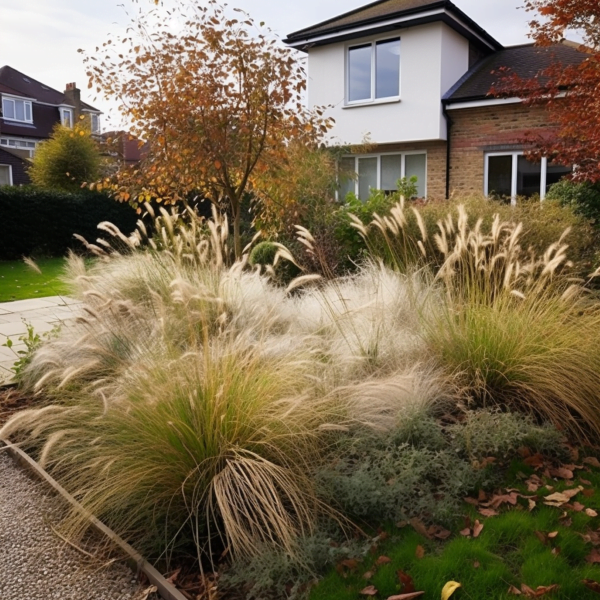A garden is often a place to escape the chaos of daily life, somewhere to connect with nature and a place to entertain with family and friends. However, an overlooked garden, suffering from a lack of privacy can make it hard for people to fully enjoy their outdoor space.
Increasing privacy in your garden will allow you to enjoy your outdoor space without worrying about prying eyes and can also create a sense of seclusion which can enhance the overall ambience of your outdoor space. Whether you mainly use your garden for relaxing, entertaining, or as a hobby; a more private garden will often make your outdoor experience more enjoyable.
In this blog post we outline some practical ways that you can increase privacy in your garden to help you create an outdoor space that you will be able to fully enjoy for years to come.
Affiliate Disclaimer: As an Amazon Associate, I earn from qualifying purchases.
1. Maximise Fencing
Maximising the height of your garden fencing is a simple way to increase privacy and help to block out unwanted sights and sounds. Fences come in a variety of materials including wood, bamboo, and metal. Fencing can help to create a more secluded garden; however, they will often block out more light. Tall fences can sometimes feel overpowering, therefore, other suggestions on this list may be worth considering.
When choosing your fencing, you will need to consider the height, material, and cost. In the UK, there are restrictions on the maximum height of fences. These are typically 2 metres (approx. 6.5 feet) for back garden fences and 1 metre (approx. 3.2 feet) for fences in front gardens. However, some areas may have additional restrictions so it is always best to seek guidance from your local council if you’re unsure.
Before installing new fencing, it is recommended that you speak with your neighbours first in order to avoid any potential upset. Some neighbours may even be willing to split the overall cost with you.
2. Use trees and tall plants
Another great way to increase privacy in your garden is to use trees and tall plants. Trees and tall plants can be used to not only provide some extra privacy, but they can also act as a natural barrier to help provide shade, reduce noise pollution, improve air quality and provide food and shelter for wildlife.
There are many different types of trees to choose from, but it is important to consider the eventual height and spread of the tree as well as any maintenance that will be needed. Evergreen trees such as conifers will provide year-round privacy whilst deciduous trees such as beech, oak or hornbeam can offer seasonal privacy with dense foliage in warmer months whilst allowing lower light in winter months.
Rows of pleached trees are becoming a popular way to create a privacy screen as they can increase privacy without taking up too much space.
3. Build a pergola
Another stylish and functional way to increase privacy in your garden is to build a pergola. A pergola consists of upright posts with supporting cross beams and typically a slatted or solid roof. A pergola is particularly effective if your garden is overlooked from above, however, side panels can also be added for increased lateral privacy. Pergolas will not only help increase privacy in your garden, but they can also help to define spaces and create focal points. Slatted roof pergolas can help provide some semi-shaded spaces which are perfect for outdoor dining and can look impressive when adorned with festoon lighting on a summers evening. When building a pergola in your garden, it is important to plan carefully so that the size and design enhances the overall appearance of your garden. In order to tie a pergola in with the rest of your garden, many people grow climbing plants over the structure, such as wisteria, clematis or grapevines.
See our related posts: 7 of the Best Climbing Plants to Grow over your Pergola in the UK and Building Your Own Budget Pergola: A Complete Guide
4. Use screening
Another effective versatile solution to creating more privacy in your garden is to install screening. Whether you’re looking to block out a neighbouring property’s sightlines, hide ugly features which are past your gardens boundaries or increase shelter from wind, screening is a versatile option. There are many different types of screening available, in a wide range of materials including wooden trellis, bamboo, metal and ‘living screens’ which are made using hedging and climbing plants.
When choosing your screening, consider a style that will complement the overall design of your garden. You will also need to consider the height, durability, and maintenance requirements of your chosen screening. By consider the direction of the sun and the sightlines from your neighbouring properties, you can minimise shade whilst maximising the added privacy your screening will provide.
5. Purchase a large parasol
Another potential solution to your gardens lack of privacy is to purchase a large parasol. Parasols are perhaps a more versatile alternative to building a permanent structure such as a pergola. There are lots of different styles, colours and materials to choose from, so I’m sure you will be able to find one that compliments your garden and outdoor furniture.
Large freestanding parasols can be moved around the garden to provide shade and privacy where it is needed. Like pergolas, a large parasol can help to define separate areas of your garden and many free-standing ones now come with weights and anchors to help keep them secure in windy conditions.
Alternatively, cantilever parasols can be permanently attached to the side of your house which can help to help create a private seating area. Whichever parasol you choose you will need to consider practical aspects such as ease of use, storage, and stability.
6. Create a sunken area
Another way to make an area of your garden more private, is to create a sunken area. A sunken garden area surrounded by tall plants or walls can provide high levels of privacy and will create a real feature in your garden. If your garden is sloping, it may be relatively easy to create a sunken area built into the natural slope of your garden. If not, it might require extensive groundworks and drainage installation which can be costly. Sunken retreats will create a unique outdoor living area perfect for entertaining and relaxing summer nights. When designing your private sunken garden area, it is important to consider the layout, materials and drainage so that your sunken area is practical and adds to the overall style of your garden.
7. Reconfigure areas of your garden
Throughout this post we have outlined different methods that can be used to increase privacy in your garden. Often even some of the most overlooked gardens will still have areas within them that are away from prying eyes. By taking this into account, you could consider reconfiguring the spaces within your garden to maximize privacy for where it is most needed. Reconfiguring spaces in your garden, for example moving a patio closer to a house, can be an effective way to avoid overlooking neighbours and increase privacy. When reconfiguring spaces, you will need to consider which areas of your garden get the sun, and which areas are overlooked.
Final thoughts
There are many ways to make your garden more private that can help you create a secluded outdoor space. By carefully planning out your garden, you can increase privacy in ways that add character and style to your garden. Whether you choose to use fencing, trees, pergolas, screening, large parasols, sunken areas or a combination of these, there are many options available to help you to create an outdoor space that you will be able to fully enjoy for years to come.



